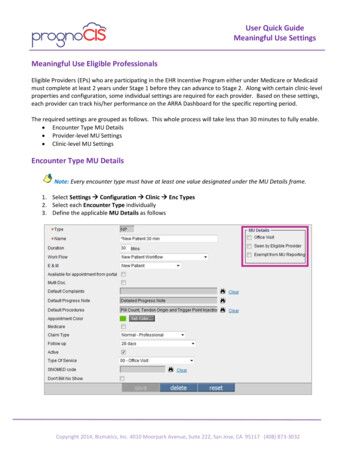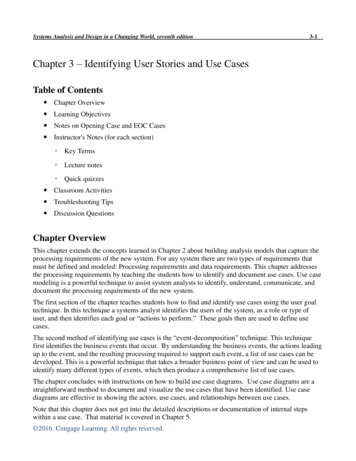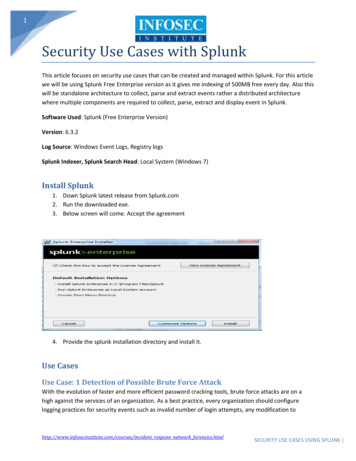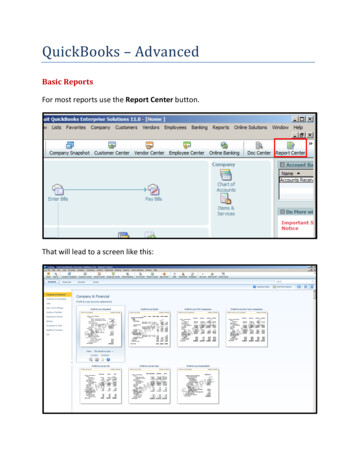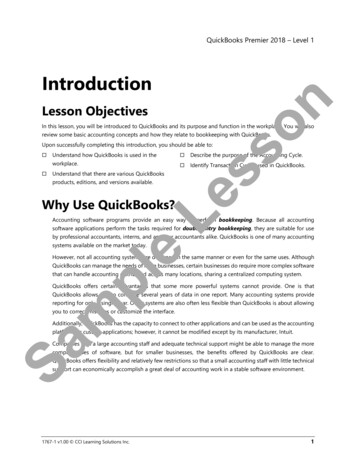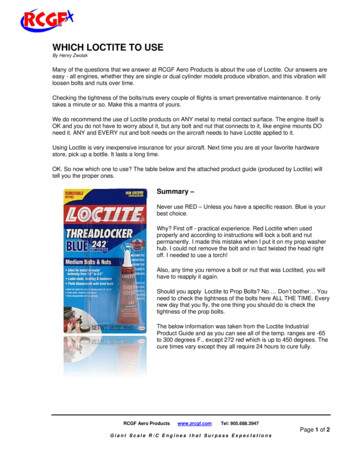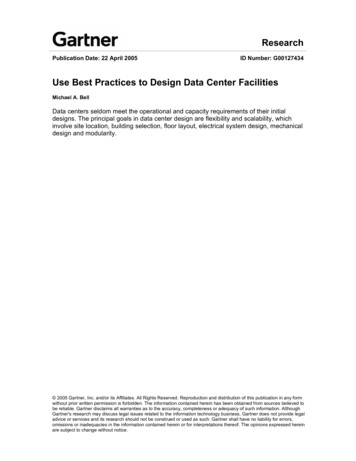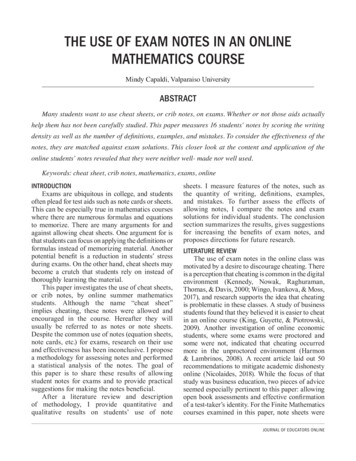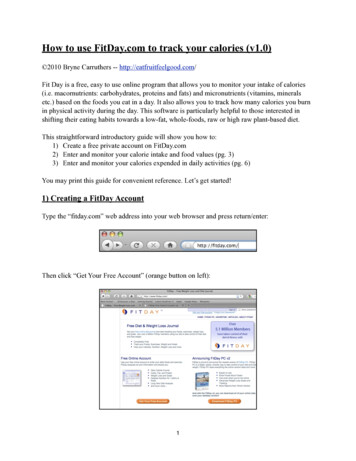
Transcription
How to use FitDay.com to track your calories (v1.0) 2010 Bryne Carruthers -- http://eatfruitfeelgood.com/Fit Day is a free, easy to use online program that allows you to monitor your intake of calories(i.e. macornutrients: carbohydrates, proteins and fats) and micronutrients (vitamins, mineralsetc.) based on the foods you eat in a day. It also allows you to track how many calories you burnin physical activity during the day. This software is particularly helpful to those interested inshifting their eating habits towards a low-fat, whole-foods, raw or high raw plant-based diet.This straightforward introductory guide will show you how to:1) Create a free private account on FitDay.com2) Enter and monitor your calorie intake and food values (pg. 3)3) Enter and monitor your calories expended in daily activities (pg. 6)You may print this guide for convenient reference. Let’s get started!1) Creating a FitDay AccountType the “fitday.com” web address into your web browser and press return/enter:Then click “Get Your Free Account” (orange button on left):1
Choose a unique username and password. First name last name numbers is an easy formulato remember (e.g. robertbarker11). Usernames are not case sensitive but passwords are. Writethese down if necessary. Enter the rest of your personal information including email address (after you’ve created your account if you want to change any of this information, click the “Profile”tab on the main screen):Scroll down and click on “I have read and agree to the terms service” checkbox then click “SignUp”. This will take you immediately to the food log window (see next page)You have now created your FitDay user account! That’s all there is to it.2
2) Tracking Your Food and Calorie Intake Using FitDayFitDay allows you to keep track of what foods you eat on a daily basis and determine the calorieand nutrient content of those foods individually and as a whole.The way it works is quite simple: you choose the type and quantity of foods you’ve eaten in aday and add them to your ‘food log’ which will calculate for you how many calories and othernutrients you’ve consumed. This saves you the trouble of doing all the number crunching yourself! In the following section we’ll show you how to do all this.Adding foods to your food logIf you’ve just created your FitDay account, you will now see your food log. Otherwise sign in toFitDay using your user name and password to take you there. To choose a food you have eaten,select “Browse Food”, “Search Food”, or “Recent Food” (column on left). I like using “SearchFood’ for finding new foods and “Recent Food” for quick selection of staple foods.3
If we do a search for ‘banana’, the following screen will come up, where we can select the specific banana-related food we’re looking for:FitDay has a very large food database, but if you cannot find the food you are looking for, youcan enter a similar item or the separate ingredients if possible.We’ll choose ‘raw banana’ (click “Add to food log”) because I like bananas 4
Now you can preview the nutrient content for this food by clicking on the various tabs (“Calories” for macronutrients, “Total Nutrition” for list of all vitamins and minerals, etc).Next select the desired quantity of the food. For most accurate results with solid foods, use akitchen scale to weigh serving portions. If you don’t know the exact weight of what you’veeaten, just enter the quantity (e.g. 2 bananas) or estimated weight.If you want to preview or change the amount click ‘Recalculate’. Once you’ve chosen the appropriate food item, click ‘Add to your food log’. This will take you back to the food log window.Repeat this process until you’ve entered all the food for the day or are done for now. The morespecific you are when searching for a food (e.g. “banana, raw” or “sweet potato, cooked”) theeasier it will be to find. If you change the amount of any food(s) already in your food log be sureto click “Save changes” before you add another food or log out. Once you’ve logged your foodintake for a number of days you can browse through food logs from different days by clicking“Show previous day” or “Show next day”.5
About Monitoring Your Calorie IntakeDon’t worry about your vitamin and mineral intake (under “Nutrition” tab) for now. Dependingon the diet you are currently eating, the daily requirement for certain nutrients may be lower thanwhat FitDay recommends (for those interested in closely tracking your intake of micronutrients Irecommend using a different program [CRON-o-Meter] which allows you to customize your required intake of all nutrients).For now just enter the foods you are currently eating into your food log and pay attention to the“Calories” tab and your percentage of carbohydrates/protein/fat (see pie chart). This will giveyou a sense of how many carbs, protein and fat are in your current diet. You may be surprised!After you’ve tracked your food intake for a few days, you may also notice shifts in your eatinghabits simply from becoming more aware of what you are currently eating without making anyconscious effort.When you feel ready you can work towards eating differently to lower your fat intake. Aim to eatbelow 20% then at/below 15%. The protocol for optimal athletic performance, treating diabetesand heart disease is at 10% calories or below on average.Try using FitDay 2-3 times a week minimum when starting out. If you are eating a more restricted low fat diet (10% of calories) and/or a 100% raw vegan diet, it is recommended to trackyour calorie intake daily for at least a few weeks.For everyone in general I recommend not restricting your calories but eating as much healthycarbohydrate foods like fruits, vegetables, whole grains, beans and legumes as you care for.Small quantities of fatty foods like nuts, seeds and avocado may be included if eaten frequentlyor in moderate quantities if eaten on occasion. If you are on a 10% calories from fat diet you maywant to avoid these foods for some period of time (e.g. 1-2 weeks) for the best and quickest results. Animal products (meat, dairy, fish, eggs) and foods containing refined sugar/flour/oilshould be eaten only in small quantities, infrequently or avoided.6
3) Monitoring Your Daily Exercise and Activities Using FitDayOnce you are comfortable adding foods to your food log and observing your calorie intake, youmay use FitDay’s fitness log to keep track of how many calories you expend during exercise andother day-to-day activities.This is of value to the health seeker since eating enough (healthy) calories is vital to optimalhealth and well being, and exercise will increase your need for calories. Eating right is also crucial to having energy to exercise, which will help make you feel great!Entering activities into your fitness logClick on the “Activities” (right beside the “Food” tab) near the top of the page:You will now see your fitness log. Adding activities to your fitness log is similar to adding foodsto your food log. Enter a particular activity (e.g. walking, swimming, gardening) in the searchbox or click “Browse Activities”:7
Next click the “Add to Activity Log” button beside your activity of choice (see image below).This will take you to back to your fitness log.Now enter the time and/or distance for your activity and click “Save Changes”. Repeat asneeded. At the bottom of the “Activities and Exercise” window you’ll be able to view your calories burned and calories eaten vs. burned (“Calorie Balance” tab):8
You now have been shown how to create your FitDay.com account, monitor your intake of calories and nutrients using your food log, and track your calories expended in daily activities usingyour fitness log.These basic features are the ones I most often use with FitDay. There are other features you canexplore on your own (including tracking changes in your weight over time), but what you havelearned here is more than enough to get you started in becoming more conscious of the foods youconsume and their effect on your health and well being.About Bryne CarruthersBryne (sounds like Brian) lives in Canada and is currently working towards his PhD in holisticnutrition. He is an international teacher on the subjects of health, wellness, diet and raw foods.He also works with individuals in improving their diet, with an emphasis on whole raw plantfoods. He is a moderator of the online raw food and fitness community 30 Bananas a Day(http://30bananasaday.com/) and has written numerous articles on the subjects of health and nutrition.He may be contacted through his website:http://eatfruitfeelgood.com/9
You now have been shown how to create your FitDay.com account, monitor your intake of calo-ries and nutrients using your food log, and track your calories expended in daily activities using your fitness log. These basic features are the ones I most often use with FitDay. There are other features you can explore on your own (including tracking changes in your weight over time), but what you .

